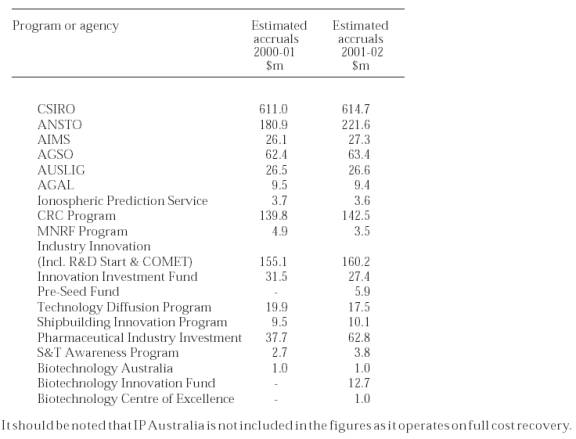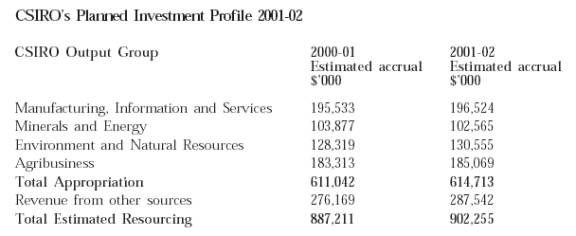
Editorial
25 May 2001
Excerpts from the Federal Government Portfolio, Budgets and Priorities 2001-02
Below is a small part of the budget papers 2001/02 dealing with research and development. The full set can be obtained from the Department of Industry Science and Resources' Web site.
The
AMA's Dr Kerryn Phelps' one liner regarding the budget's support for the medical
profession, would seem at least as apt with regard to R&D -- "Steady as
she sinks".
Country
|
Overall
Support
|
Public
Support
|
Industry
Support
|
|
Sweden |
1 |
3 |
1 |
|
Finland |
2 |
2 |
3 |
|
Iceland |
10 |
1 |
20 |
|
Netherlands |
12 |
4 |
15 |
|
Australia |
19 |
6 |
21 |
|
New Zealand |
22 |
5 |
25 |
Derived
from the Government's "Australian
R&D Indicators in an International Context (May, 2001)"
Budgets
& Priorities - EDUCATION, TRAINING AND YOUTH AFFAIRS
Science and Technology in the Portfolio Budget
Through
the Education, Training and Youth Affairs portfolio, Australian universities are
estimated to access approximately $1.9 billion in 2001-02 to support research
and research training. This estimate comprises over $1.6 billion of funding
under the Higher Education Funding Act (HEFA) 1988 including $1007.5
million in program funding administered by the Department of Education, Training
and Youth Affairs (DETYA) and approximately $600 million as an estimate of
additional funding sourced from universities' operating grant. The remainder
includes the Australian Research Council's National Competitive Grants Program (NCGP) ($262.4 million) to be funded under the new Australian Research
Council Act 2001, and other Budget appropriations ($6.1 million).
Funding allocations at the Scheme level are provided on
a calendar year basis for the year 2001.
University
Operating Grants The Commonwealth is the major source of research
income for universities and, given that universities perform the bulk of
Australia's basic research, the major source of funding for basic research in
general. Universities' operating grants also provide a source of funding for
research activities.
The
estimate of the total funding sourced by universities from the operating grant
is based on the Australian Bureau of Statistics (ABS) survey of research
expenditure of universities by source of funds (the ABS methodology is outlined
in Research and Experimental Development, Higher Education Organisations (8111.0)).
One of the sources of funds for research expenditure identified by the ABS is
General University Funds (GUF). Universities' operating grants comprise the
major part of GUF, and can be estimated by using the operating revenue figures
available in the DETYA Selected Higher Education Finance Statistics.
Using this method, additional funding sourced from university operating grants
for calendar year 2001 is estimated to be approximately $800 million.
In
2001, within this estimate, two elements of operating grant funding can be
identified:
· The Research Quantum (RQ):
The RQ is a component of universities' operating grant which is allocated to
institutions on the basis of research performance, as measured by the Composite
Index. In 2001, RQ funding will total $228.1 million. In 2002, the RQ will be
incorporated into the new Institutional Grants Scheme.
· Funding for the schools and centres of the
Institute of Advanced Studies (IAS) of
the Australian National University. The block grant for the IAS is estimated to
be approximately $154 million for 2001. From 2002, the new research funding
framework will make provision for the IAS to access performance-based funding,
through a contribution from this block grant.
In
calendar year 2002, with the cessation of the RQ, the estimated funding sourced
from university operating grants is estimated to be approximately $600 million.
Institutional
Grants Scheme
The Institutional Grants Scheme (IGS) will support the
general fabric of institutions’ research and research training activities, and
assist institutions in responding flexibly to their environment in accordance
with their own strategic judgments. Funding under the IGS will be allocated on
the basis of a formula that reflects success in attracting research income from
a diversity of sources (60 per cent), in attracting research students (30 per
cent), and in the quality and output of its research publications (10 per cent).
Research income from all sources will be equally weighted. The Scheme absorbs
funding previously allocated for the Research Quantum and the Small Research
Grants Scheme.
Research
Training Scheme
This
Scheme will provide funding for research training according to a
performance-based formula. Institutions will attract a number of scholarship
places based on their performance through a formula comprising three elements:
numbers of all research students completing their degrees (50 per cent
research; income (40 per cent); and publications (10 per cent). The value for
each element will be the average of the latest two years’ data.
Research
Infrastructure Block Grants
The
Research Infrastructure Block Grants Scheme will continue under the new
framework. Additional funding for this scheme has been made available under the
Innovation Action Plan, Backing Australia's Ability (see Section 2).
Systemic
Research Infrastructure
The Systemic Research Infrastructure Scheme was
announced in the Innovation Action Plan, Backing Australia's Ability,
and is directed primarily towards infrastructure projects which have strategic
benefits for the sector as a whole. There will be $25.7 million available in
2002 when this Scheme commences (see Section 2).
Higher
education research and research training priorities
The
funding and policy framework for research and research training announced in Knowledge
and Innovation in December 1999 will continue to drive priorities, as
implementation continues during 2001/02. This framework is designed to:
· ensure Australia is able to maintain and develop
its research competence and international credibility across a wide range of
fields of knowledge;
· facilitate the provision of diverse, high
quality research training environments;
· expand opportunities and choice for research
students;
· encourage the expansion of the total national
investment in research;
· enable research organisations to respond
flexibly to changes in the development of and demand for knowledge;
· extend the contributions of higher education
research to the national innovation system through closer links with industry;
and
· support the development and dissemination of
knowledge for its own sake as well as the economic, social and cultural benefits
it will bring to the wider community.
The
major objectives and planned achievements for the Department of Industry,
Science and Resources (ISR) in 2001-02 include the:

The MNRF Program is directed at keeping Australia at
the leading edge of scientific and technological developments. Under the
Program, funding is provided for facilities in a range of key scientific fields
where the establishment costs are beyond the capacity of any individual
Australian institution. These facilities create centres of capability for
pursuing research with state-of-the-art equipment.
CSIRO seeks to secure maximum benefits from R&D for
Australia by assembling strong interdisciplinary teams that are internationally
competitive, and focusing effort on those areas where there are firm signals of
strong commercial or community support for CSIRO's research. CSIRO's planned
investment of appropriation funds for its output groups are in the accompanying
table.

May we rest in peace.
Alex
Reisner
The Funneled Web